The Cambridge History of Japan, Vol. 4: Early Modern Japan
Подождите немного. Документ загружается.

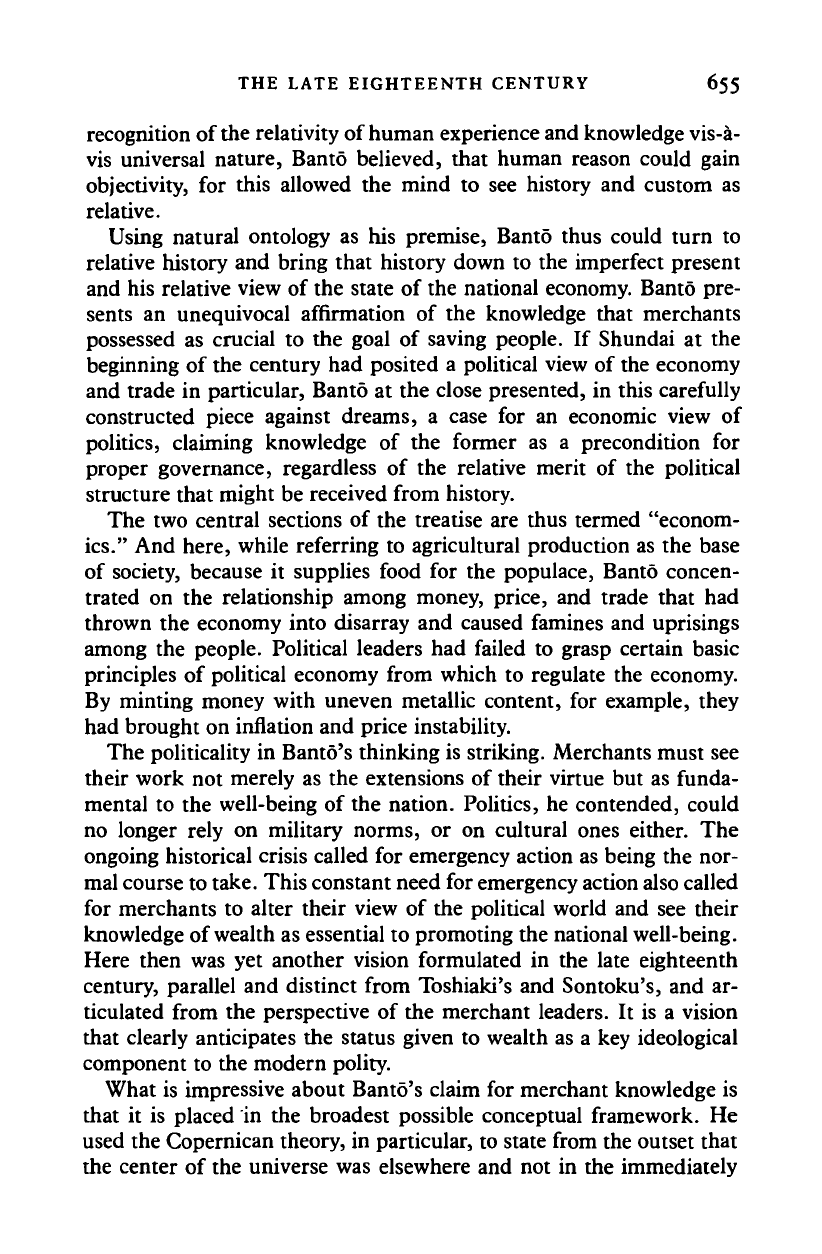
THE LATE EIGHTEENTH CENTURY 655
recognition of
the
relativity of human experience and knowledge vis-a-
vis universal nature, Banto believed, that human reason could gain
objectivity, for this allowed the mind to see history and custom as
relative.
Using natural ontology as his premise, Banto thus could turn to
relative history and bring that history down to the imperfect present
and his relative view of the state of the national economy. Banto pre-
sents an unequivocal affirmation of the knowledge that merchants
possessed as crucial to the goal of saving people. If Shundai at the
beginning of the century had posited a political view of the economy
and trade in particular, Banto at the close presented, in this carefully
constructed piece against dreams, a case for an economic view of
politics, claiming knowledge of the former as a precondition for
proper governance, regardless of the relative merit of the political
structure that might be received from history.
The two central sections of the treatise are thus termed "econom-
ics."
And here, while referring to agricultural production as the base
of society, because it supplies food for the populace, Banto concen-
trated on the relationship among money, price, and trade that had
thrown the economy into disarray and caused famines and uprisings
among the people. Political leaders had failed to grasp certain basic
principles of political economy from which to regulate the economy.
By minting money with uneven metallic content, for example, they
had brought on inflation and price instability.
The politicality in Banto's thinking is striking. Merchants must see
their work not merely as the extensions of their virtue but as funda-
mental to the well-being of the nation. Politics, he contended, could
no longer rely on military norms, or on cultural ones either. The
ongoing historical crisis called for emergency action as being the nor-
mal course to take. This constant need for emergency action also called
for merchants to alter their view of the political world and see their
knowledge of wealth as essential to promoting the national well-being.
Here then was yet another vision formulated in the late eighteenth
century, parallel and distinct from Toshiaki's and Sontoku's, and ar-
ticulated from the perspective of the merchant leaders. It is a vision
that clearly anticipates the status given to wealth as a key ideological
component to the modern polity.
What is impressive about Banto's claim for merchant knowledge is
that it is placed in the broadest possible conceptual framework. He
used the Copernican theory, in particular, to state from the outset that
the center of the universe was elsewhere and not in the immediately
Cambridge Histories Online © Cambridge University Press, 2008
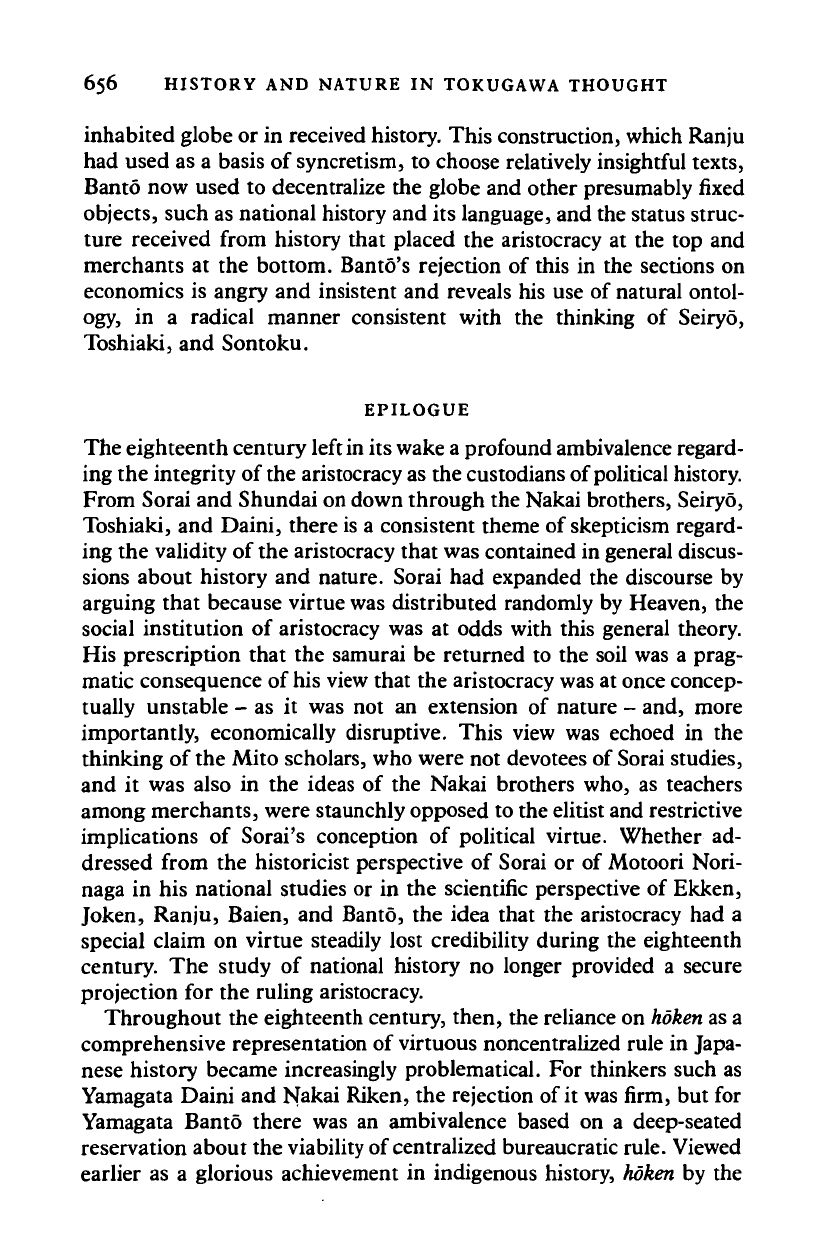
656 HISTORY AND NATURE IN TOKUGAWA THOUGHT
inhabited globe or in received history. This construction, which Ranju
had used as a basis of syncretism, to choose relatively insightful texts,
Banto now used to decentralize the globe and other presumably fixed
objects, such as national history and its language, and the status struc-
ture received from history that placed the aristocracy at the top and
merchants at the bottom. Banto's rejection of this in the sections on
economics is angry and insistent and reveals his use of natural ontol-
ogy, in a radical manner consistent with the thinking of Seiryo,
Toshiaki, and Sontoku.
EPILOGUE
The eighteenth century left
in
its wake
a
profound ambivalence regard-
ing the integrity of the aristocracy as the custodians of political history.
From Sorai and Shundai on down through the Nakai brothers, Seiryo,
Toshiaki, and Daini, there is a consistent theme of skepticism regard-
ing the validity of the aristocracy that was contained in general discus-
sions about history and nature. Sorai had expanded the discourse by
arguing that because virtue was distributed randomly by Heaven, the
social institution of aristocracy was at odds with this general theory.
His prescription that the samurai be returned to the soil was a prag-
matic consequence of
his
view that the aristocracy was at once concep-
tually unstable - as it was not an extension of nature - and, more
importantly, economically disruptive. This view was echoed in the
thinking of the Mito scholars, who were not devotees of Sorai studies,
and it was also in the ideas of the Nakai brothers who, as teachers
among merchants, were staunchly opposed to the elitist and restrictive
implications of Sorai's conception of political virtue. Whether ad-
dressed from the historicist perspective of Sorai or of Motoori Nori-
naga in his national studies or in the scientific perspective of Ekken,
Joken, Ranju, Baien, and Banto, the idea that the aristocracy had a
special claim on virtue steadily lost credibility during the eighteenth
century. The study of national history no longer provided a secure
projection for the ruling aristocracy.
Throughout the eighteenth century, then, the reliance on
hoken
as a
comprehensive representation of virtuous noncentralized rule in Japa-
nese history became increasingly problematical. For thinkers such as
Yamagata Daini and Nakai Riken, the rejection of it was firm, but for
Yamagata Banto there was an ambivalence based on a deep-seated
reservation about the viability of centralized bureaucratic rule. Viewed
earlier as a glorious achievement in indigenous history,
hoken
by the
Cambridge Histories Online © Cambridge University Press, 2008
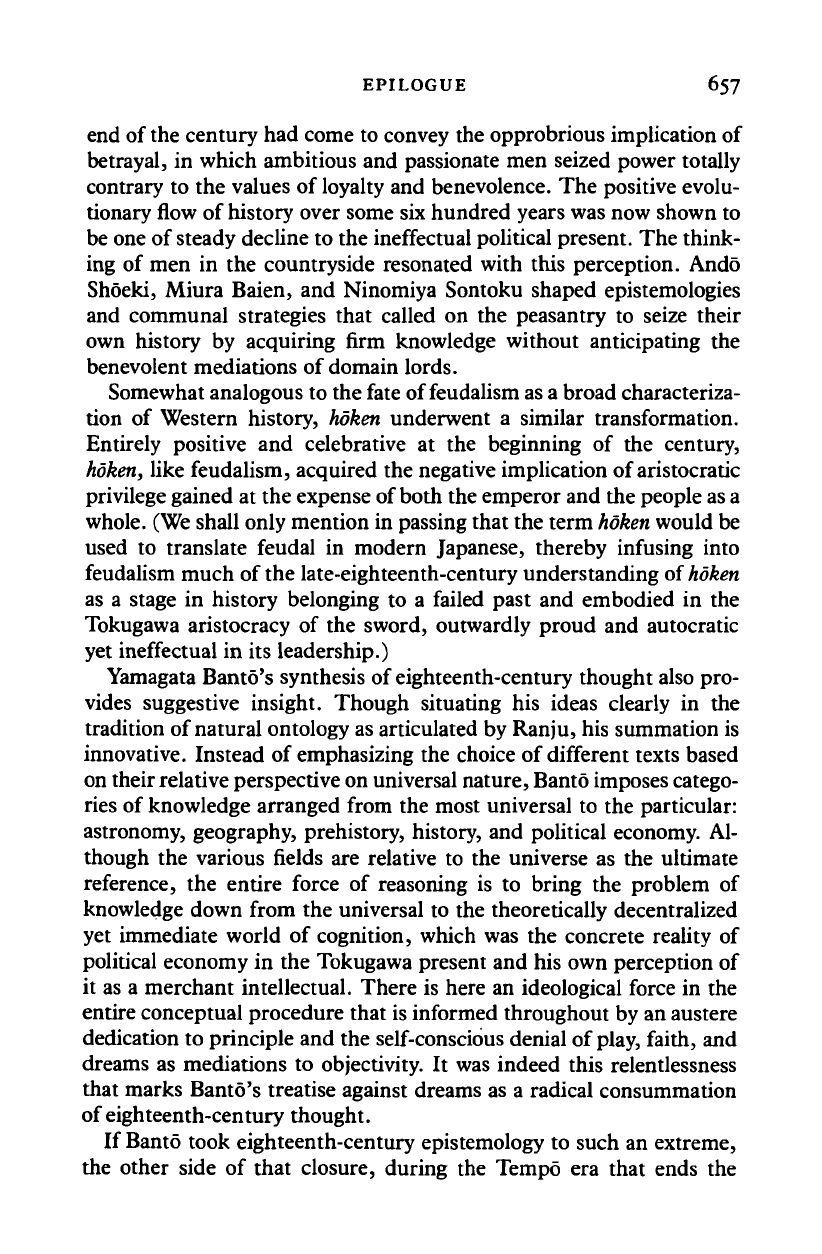
EPILOGUE 657
end of the century had come to convey the opprobrious implication of
betrayal, in which ambitious and passionate men seized power totally
contrary to the values of loyalty and benevolence. The positive evolu-
tionary flow of history over some six hundred years was now shown to
be one of steady decline to the ineffectual political present. The think-
ing of men in the countryside resonated with this perception. Ando
Shoeki, Miura Baien, and Ninomiya Sontoku shaped epistemologies
and communal strategies that called on the peasantry to seize their
own history by acquiring firm knowledge without anticipating the
benevolent mediations of domain lords.
Somewhat analogous to the fate of feudalism as
a
broad characteriza-
tion of Western history, hoken underwent a similar transformation.
Entirely positive and celebrative at the beginning of the century,
hoken,
like feudalism, acquired the negative implication of aristocratic
privilege gained at the expense of both the emperor and the people as
a
whole. (We shall only mention in passing that the term
hoken
would be
used to translate feudal in modern Japanese, thereby infusing into
feudalism much of the late-eighteenth-century understanding of
hoken
as a stage in history belonging to a failed past and embodied in the
Tokugawa aristocracy of the sword, outwardly proud and autocratic
yet ineffectual in its leadership.)
Yamagata Banto's synthesis of eighteenth-century thought also pro-
vides suggestive insight. Though situating his ideas clearly in the
tradition of natural ontology as articulated by Ranju, his summation is
innovative. Instead of emphasizing the choice of different texts based
on their relative perspective on universal nature, Banto imposes catego-
ries of knowledge arranged from the most universal to the particular:
astronomy, geography, prehistory, history, and political economy. Al-
though the various fields are relative to the universe as the ultimate
reference, the entire force of reasoning is to bring the problem of
knowledge down from the universal to the theoretically decentralized
yet immediate world of cognition, which was the concrete reality of
political economy in the Tokugawa present and his own perception of
it as a merchant intellectual. There is here an ideological force in the
entire conceptual procedure that is informed throughout by an austere
dedication to principle and the self-conscious denial of play, faith, and
dreams as mediations to objectivity. It was indeed this relentlessness
that marks Banto's treatise against dreams as a radical consummation
of eighteenth-century thought.
If Banto took eighteenth-century epistemology to such an extreme,
the other side of that closure, during the Tempo era that ends the
Cambridge Histories Online © Cambridge University Press, 2008
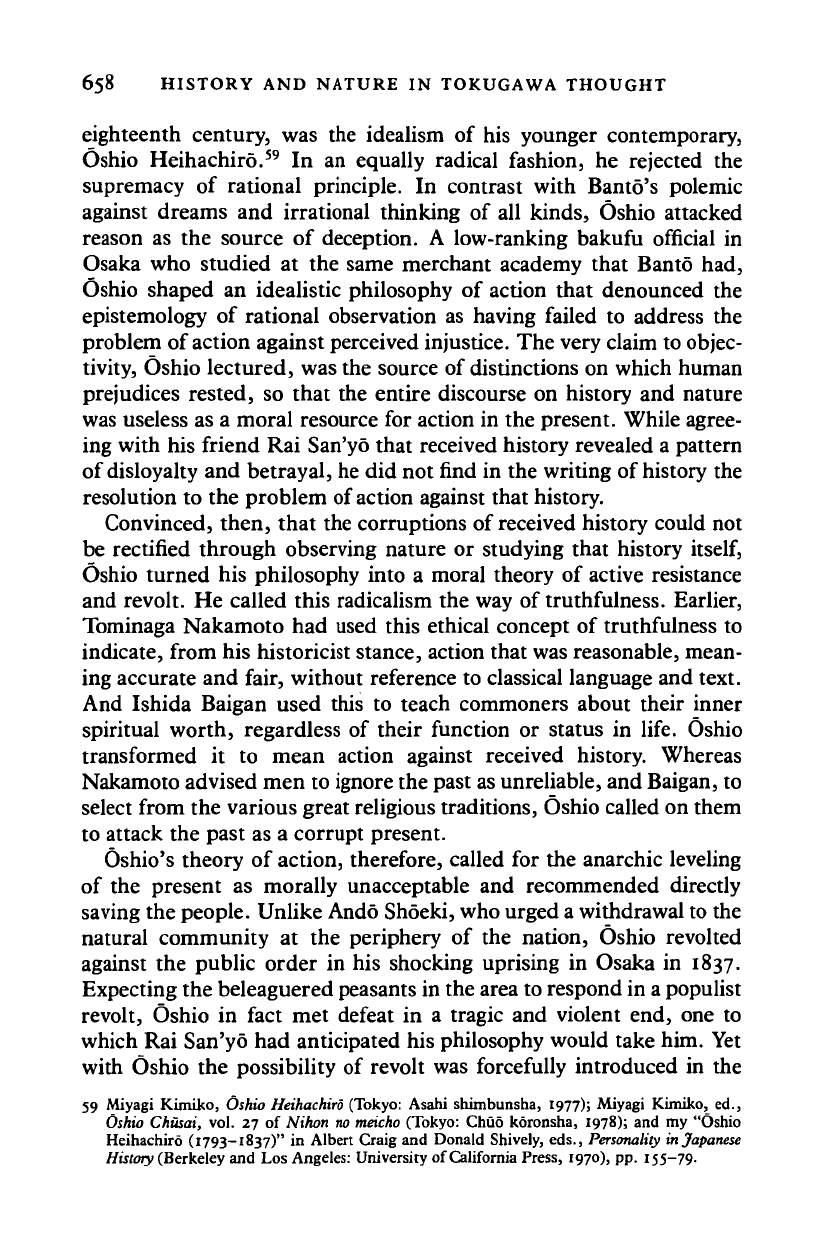
658 HISTORY AND NATURE IN TOKUGAWA THOUGHT
eighteenth century, was the idealism of his younger contemporary,
Oshio Heihachiro.
59
In an equally radical fashion, he rejected the
supremacy of rational principle. In contrast with Banto's polemic
against dreams and irrational thinking of all kinds, Oshio attacked
reason as the source of deception. A low-ranking bakufu official in
Osaka who studied at the same merchant academy that Banto had,
Oshio shaped an idealistic philosophy of action that denounced the
epistemology of rational observation as having failed to address the
problem of action against perceived injustice. The very claim to objec-
tivity, Oshio lectured, was the source of distinctions on which human
prejudices rested, so that the entire discourse on history and nature
was useless as a moral resource for action in the present. While agree-
ing with his friend Rai San'yo that received history revealed a pattern
of disloyalty and betrayal, he did not find in the writing of history the
resolution to the problem of action against that history.
Convinced, then, that the corruptions of received history could not
be rectified through observing nature or studying that history
itself,
Oshio turned his philosophy into a moral theory of active resistance
and revolt. He called this radicalism the way of truthfulness. Earlier,
Tominaga Nakamoto had used this ethical concept of truthfulness to
indicate, from his historicist stance, action that was reasonable, mean-
ing accurate and fair, without reference to classical language and text.
And Ishida Baigan used this to teach commoners about their inner
spiritual worth, regardless of their function or status in life. Oshio
transformed it to mean action against received history. Whereas
Nakamoto advised men to ignore the past as unreliable, and Baigan, to
select from the various great religious traditions, Oshio called on them
to attack the past as a corrupt present.
Oshio's theory of action, therefore, called for the anarchic leveling
of the present as morally unacceptable and recommended directly
saving the people. Unlike Ando Shoeki, who urged a withdrawal to the
natural community at the periphery of the nation, Oshio revolted
against the public order in his shocking uprising in Osaka in 1837.
Expecting the beleaguered peasants in the area to respond in
a
populist
revolt, Oshio in fact met defeat in a tragic and violent end, one to
which Rai San'yo had anticipated his philosophy would take him. Yet
with Oshio the possibility of revolt was forcefully introduced in the
59 Miyagi Kimiko, Oshio Heihachiro (Tokyo: Asahi shimbunsha, 1977); Miyagi Kimiko, ed.,
Oshio Chusai, vol. 27 of Nihon no meicho (Tokyo: Chud koronsha, 1978); and my "Oshio
Heihachiro (1793-1837)" in Albert Craig and Donald Shively, eds., Personality in Japanese
History (Berkeley and Los Angeles: University of California Press, 1970), pp. 155-79.
Cambridge Histories Online © Cambridge University Press, 2008
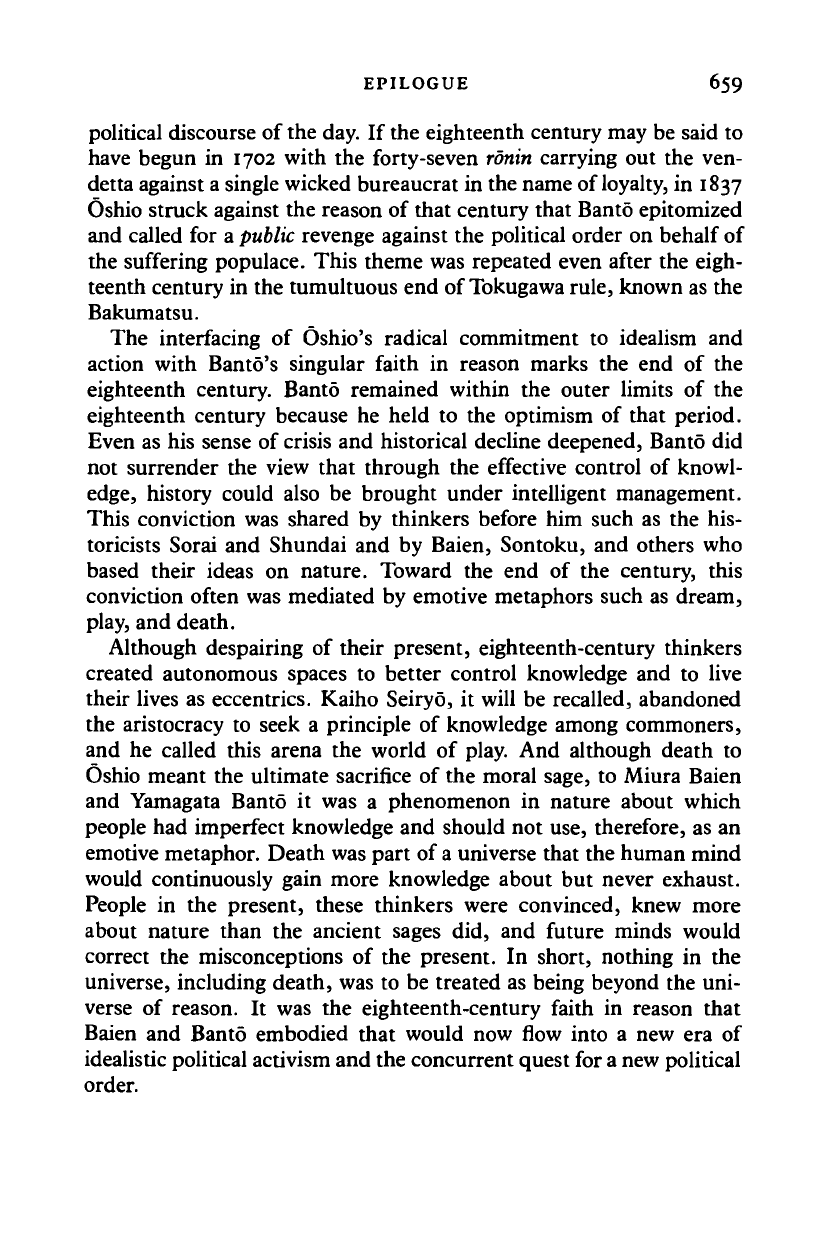
EPILOGUE 659
political discourse of the day. If the eighteenth century may be said to
have begun in 1702 with the forty-seven
ronin
carrying out the ven-
detta against a single wicked bureaucrat in the name of loyalty, in 1837
Oshio struck against the reason of that century that Banto epitomized
and called for a
public
revenge against the political order on behalf of
the suffering populace. This theme was repeated even after the eigh-
teenth century in the tumultuous end of Tokugawa rule, known as the
Bakumatsu.
The interfacing of Oshio's radical commitment to idealism and
action with Banto's singular faith in reason marks the end of the
eighteenth century. Banto remained within the outer limits of the
eighteenth century because he held to the optimism of that period.
Even as his sense of crisis and historical decline deepened, Banto did
not surrender the view that through the effective control of knowl-
edge,
history could also be brought under intelligent management.
This conviction was shared by thinkers before him such as the his-
toricists Sorai and Shundai and by Baien, Sontoku, and others who
based their ideas on nature. Toward the end of the century, this
conviction often was mediated by emotive metaphors such as dream,
play, and death.
Although despairing of their present, eighteenth-century thinkers
created autonomous spaces to better control knowledge and to live
their lives as eccentrics. Kaiho Seiryo, it will be recalled, abandoned
the aristocracy to seek a principle of knowledge among commoners,
and he called this arena the world of play. And although death to
Oshio meant the ultimate sacrifice of the moral sage, to Miura Baien
and Yamagata Banto it was a phenomenon in nature about which
people had imperfect knowledge and should not use, therefore, as an
emotive metaphor. Death was part of
a
universe that the human mind
would continuously gain more knowledge about but never exhaust.
People in the present, these thinkers were convinced, knew more
about nature than the ancient sages did, and future minds would
correct the misconceptions of the present. In short, nothing in the
universe, including death, was to be treated as being beyond the uni-
verse of reason. It was the eighteenth-century faith in reason that
Baien and Banto embodied that would now flow into a new era of
idealistic political activism and the concurrent quest for a new political
order.
Cambridge Histories Online © Cambridge University Press, 2008
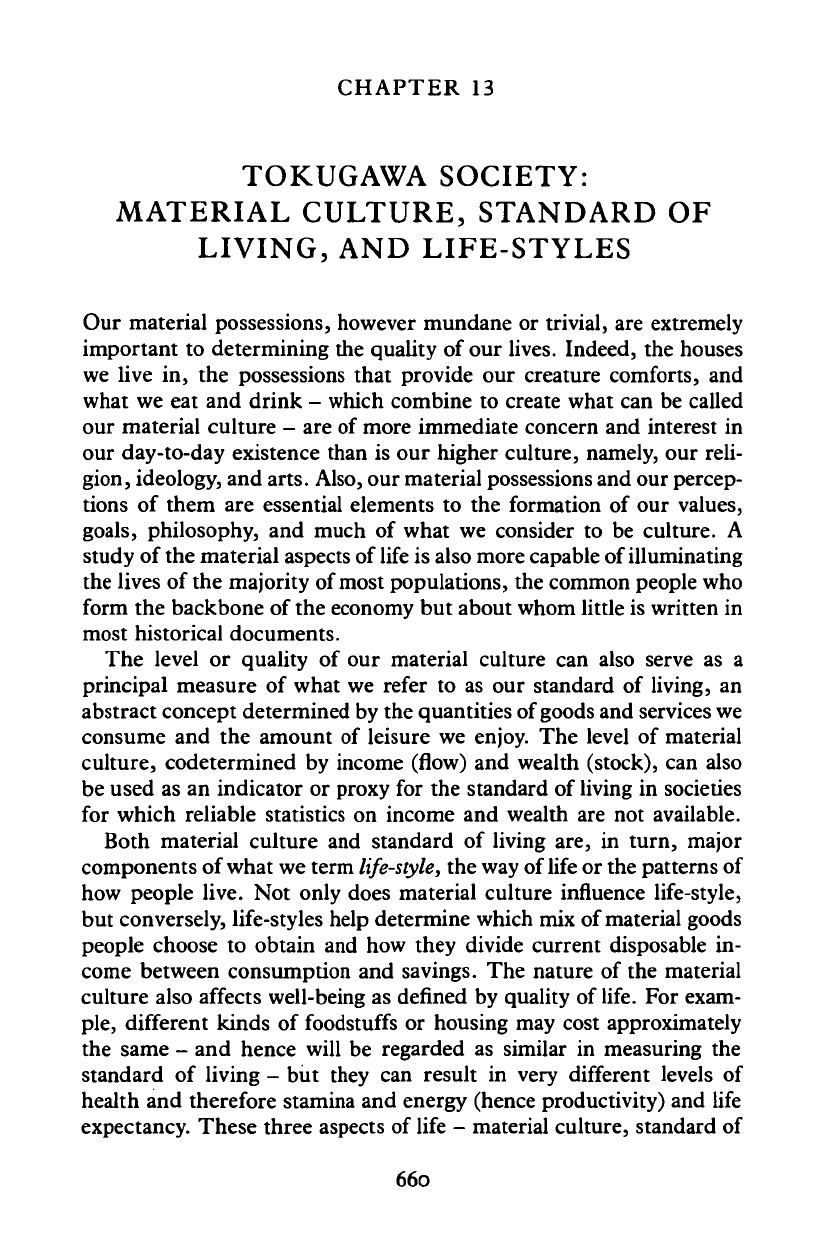
CHAPTER
13
TOKUGAWA SOCIETY:
MATERIAL CULTURE, STANDARD OF
LIVING, AND LIFE-STYLES
Our material possessions, however mundane or trivial, are extremely
important to determining the quality of our lives. Indeed, the houses
we live in, the possessions that provide our creature comforts, and
what we eat and drink - which combine to create what can be called
our material culture - are of more immediate concern and interest in
our day-to-day existence than is our higher culture, namely, our reli-
gion, ideology, and arts.
Also,
our material possessions and our percep-
tions of them are essential elements to the formation of our values,
goals,
philosophy, and much of what we consider to be culture. A
study of the material aspects of life is also more capable of illuminating
the lives of the majority of most populations, the common people who
form the backbone of the economy but about whom little is written in
most historical documents.
The level or quality of our material culture can also serve as a
principal measure of what we refer to as our standard of living, an
abstract concept determined by the quantities of goods and services we
consume and the amount of leisure we enjoy. The level of material
culture, codetermined by income (flow) and wealth (stock), can also
be used as an indicator or proxy for the standard of living in societies
for which reliable statistics on income and wealth are not available.
Both material culture and standard of living are, in turn, major
components of what we term lifestyle, the way of life or the patterns of
how people live. Not only does material culture influence life-style,
but conversely, life-styles help determine which mix of material goods
people choose to obtain and how they divide current disposable in-
come between consumption and savings. The nature of the material
culture also affects well-being as defined by quality of life. For exam-
ple,
different kinds of foodstuffs or housing may cost approximately
the same - and hence will be regarded as similar in measuring the
standard of living - but they can result in very different levels of
health and therefore stamina and energy (hence productivity) and life
expectancy. These three aspects of life - material culture, standard of
660
Cambridge Histories Online © Cambridge University Press, 2008
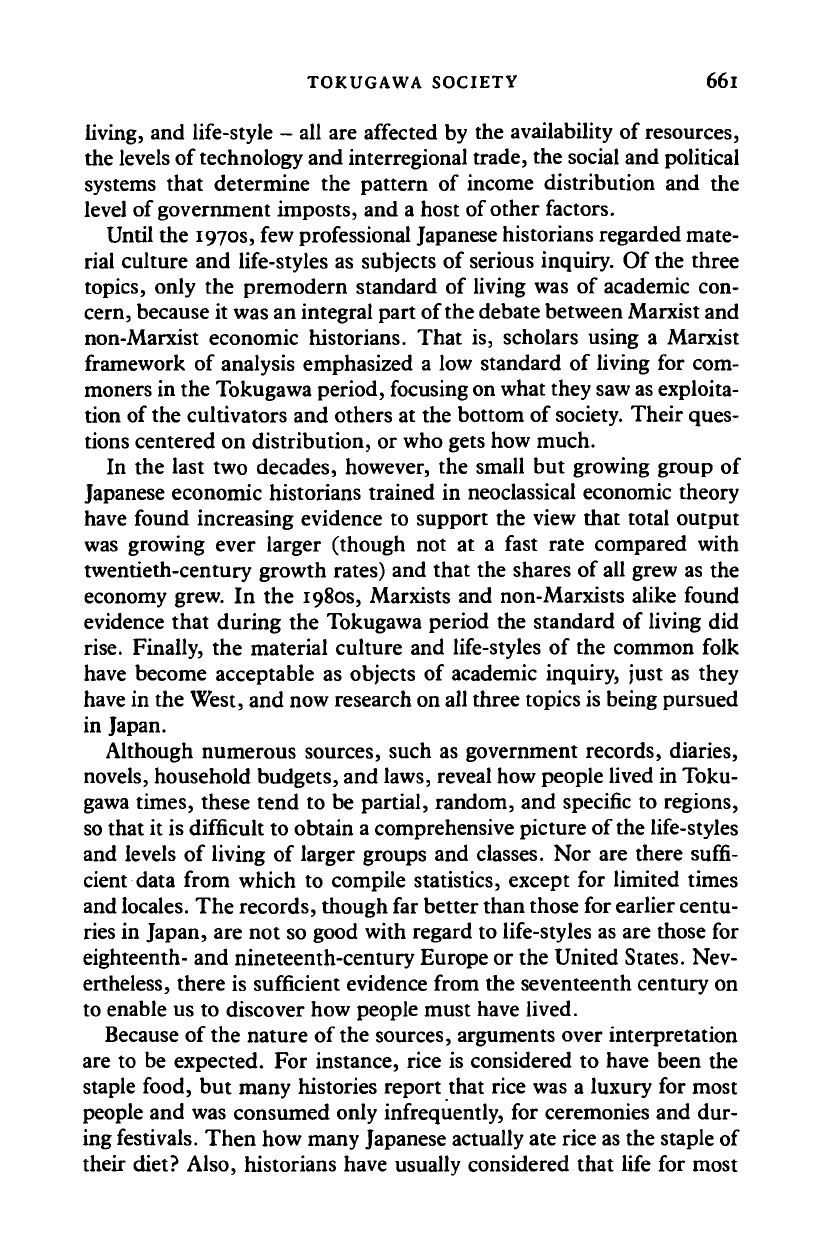
TOKUGAWA SOCIETY 66l
living, and life-style - all are affected by the availability of resources,
the levels of technology and interregional trade, the social and political
systems that determine the pattern of income distribution and the
level of government imposts, and a host of other factors.
Until the 1970s, few professional Japanese historians regarded mate-
rial culture and life-styles as subjects of serious inquiry. Of the three
topics, only the premodern standard of living was of academic con-
cern, because it was an integral part of the debate between Marxist and
non-Marxist economic historians. That is, scholars using a Marxist
framework of analysis emphasized a low standard of living for com-
moners in the Tokugawa period, focusing
on
what they saw
as
exploita-
tion of the cultivators and others at the bottom of
society.
Their ques-
tions centered on distribution, or who gets how much.
In the last two decades, however, the small but growing group of
Japanese economic historians trained in neoclassical economic theory
have found increasing evidence to support the view that total output
was growing ever larger (though not at a fast rate compared with
twentieth-century growth rates) and that the shares of all grew as the
economy grew. In the 1980s, Marxists and non-Marxists alike found
evidence that during the Tokugawa period the standard of living did
rise.
Finally, the material culture and life-styles of the common folk
have become acceptable as objects of academic inquiry, just as they
have in the West, and now research on all three topics is being pursued
in Japan.
Although numerous sources, such as government records, diaries,
novels, household budgets, and laws, reveal how people lived in Toku-
gawa times, these tend to be partial, random, and specific to regions,
so that it is difficult to obtain a comprehensive picture of
the
life-styles
and levels of living of larger groups and classes. Nor are there suffi-
cient data from which to compile statistics, except for limited times
and
locales.
The records, though far better than those for earlier centu-
ries in Japan, are not so good with regard to life-styles as are those for
eighteenth- and nineteenth-century Europe or the United States. Nev-
ertheless, there is sufficient evidence from the seventeenth century on
to enable us to discover how people must have lived.
Because of the nature of the sources, arguments over interpretation
are to be expected. For instance, rice is considered to have been the
staple food, but many histories report that rice was a luxury for most
people and was consumed only infrequently, for ceremonies and dur-
ing festivals. Then how many Japanese actually ate rice as the staple of
their diet? Also, historians have usually considered that life for most
Cambridge Histories Online © Cambridge University Press, 2008
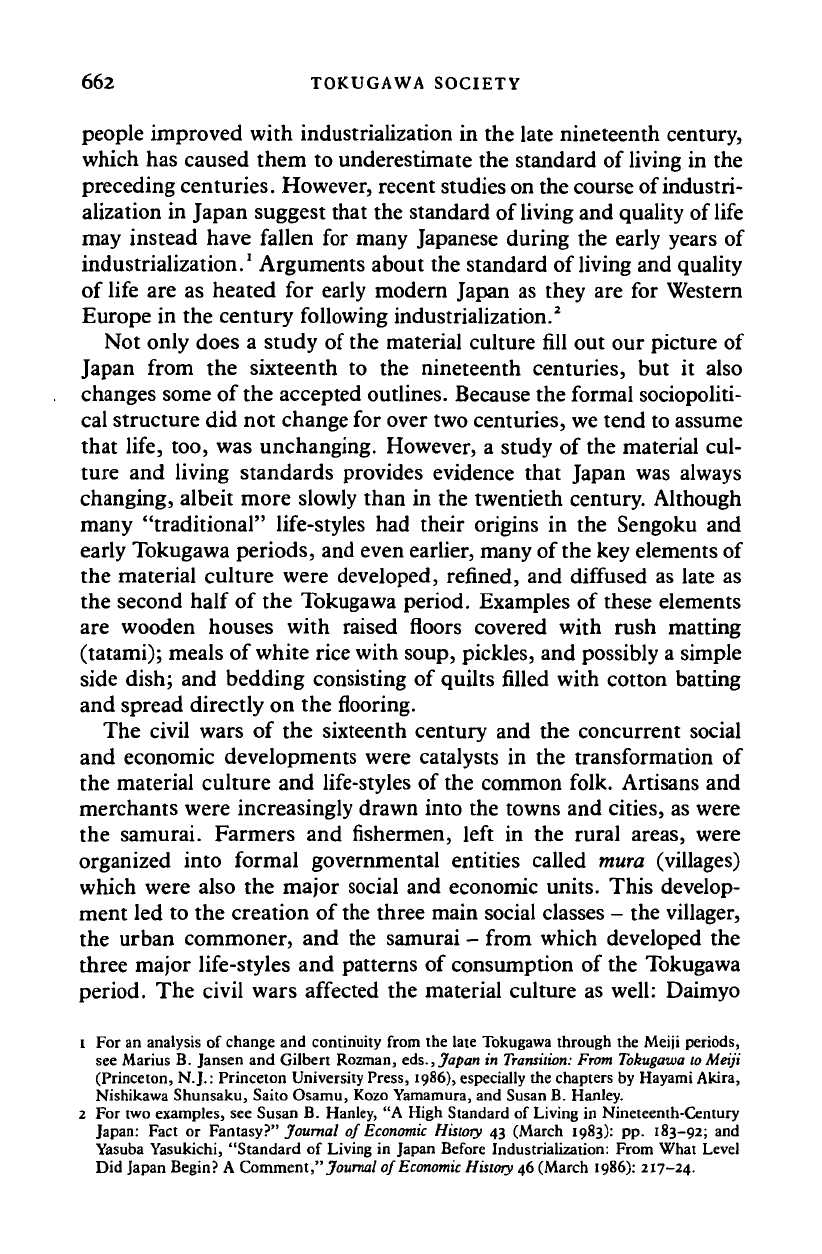
662 TOKUGAWA SOCIETY
people improved with industrialization in the late nineteenth century,
which has caused them to underestimate the standard of living in the
preceding centuries. However, recent studies on the course of industri-
alization in Japan suggest that the standard of living and quality of life
may instead have fallen for many Japanese during the early years of
industrialization.
1
Arguments about the standard of living and quality
of life are as heated for early modern Japan as they are for Western
Europe in the century following industrialization.
2
Not only does a study of the material culture fill out our picture of
Japan from the sixteenth to the nineteenth centuries, but it also
changes some of the accepted outlines. Because the formal sociopoliti-
cal structure did not change for over two centuries, we tend to assume
that life, too, was unchanging. However, a study of the material cul-
ture and living standards provides evidence that Japan was always
changing, albeit more slowly than in the twentieth century. Although
many "traditional" life-styles had their origins in the Sengoku and
early Tokugawa periods, and even earlier, many of the key elements of
the material culture were developed, refined, and diffused as late as
the second half of the Tokugawa period. Examples of these elements
are wooden houses with raised floors covered with rush matting
(tatami); meals of white rice with soup, pickles, and possibly a simple
side dish; and bedding consisting of quilts filled with cotton batting
and spread directly on the flooring.
The civil wars of the sixteenth century and the concurrent social
and economic developments were catalysts in the transformation of
the material culture and life-styles of the common folk. Artisans and
merchants were increasingly drawn into the towns and cities, as were
the samurai. Farmers and fishermen, left in the rural areas, were
organized into formal governmental entities called mura (villages)
which were also the major social and economic units. This develop-
ment led to the creation of the three main social classes - the villager,
the urban commoner, and the samurai - from which developed the
three major life-styles and patterns of consumption of the Tokugawa
period. The civil wars affected the material culture as well: Daimyo
1 For an analysis of change and continuity from the late Tokugawa through the Meiji periods,
see Marius B. Jansen and Gilbert Rozman, eds., Japan in
Transition:
From Tokugawa to Meiji
(Princeton, N.J.: Princeton University Press, 1986), especially the chapters by Hayami Akira,
Nishikawa Shunsaku, Saito Osamu, Kozo Yamamura, and Susan B. Hanley.
2 For two examples, see Susan B. Hanley, "A High Standard of Living in Nineteenth-Century
Japan: Fact or Fantasy?" Journal of Economic History 43 (March 1983): pp. 183-92; and
Yasuba Yasukichi, "Standard of Living in Japan Before Industrialization: From What Level
Did Japan Begin? A Comment," Journal of Economic History 46 (March 1986): 217-24.
Cambridge Histories Online © Cambridge University Press, 2008
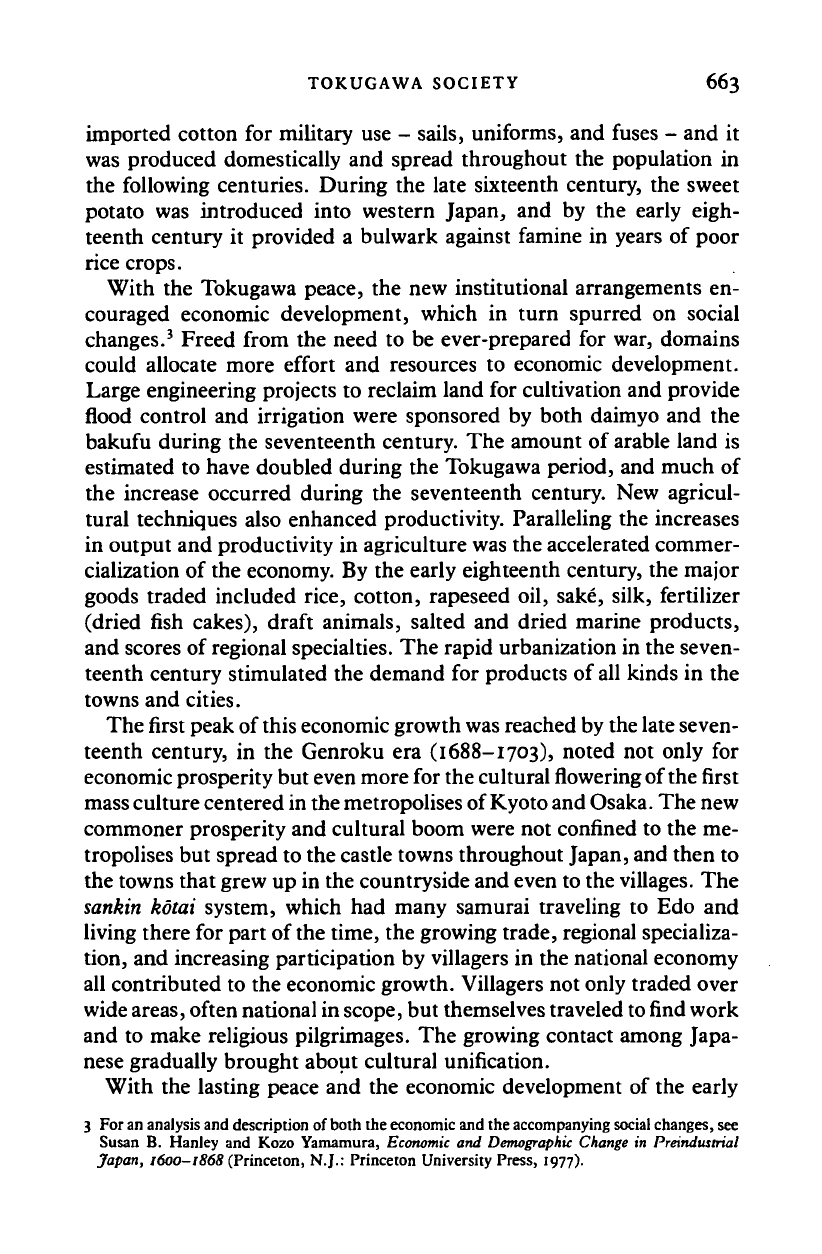
TOKUGAWA SOCIETY 663
imported cotton for military use - sails, uniforms, and fuses - and it
was produced domestically and spread throughout the population in
the following centuries. During the late sixteenth century, the sweet
potato was introduced into western Japan, and by the early eigh-
teenth century it provided a bulwark against famine in years of poor
rice
crops.
With the Tokugawa peace, the new institutional arrangements en-
couraged economic development, which in turn spurred on social
changes.
3
Freed from the need to be ever-prepared for war, domains
could allocate more effort and resources to economic development.
Large engineering projects to reclaim land for cultivation and provide
flood control and irrigation were sponsored by both daimyo and the
bakufu during the seventeenth century. The amount of arable land is
estimated to have doubled during the Tokugawa period, and much of
the increase occurred during the seventeenth century. New agricul-
tural techniques also enhanced productivity. Paralleling the increases
in output and productivity in agriculture was the accelerated commer-
cialization of the economy. By the early eighteenth century, the major
goods traded included rice, cotton, rapeseed oil, sake, silk, fertilizer
(dried fish cakes), draft animals, salted and dried marine products,
and scores of regional specialties. The rapid urbanization in the seven-
teenth century stimulated the demand for products of all kinds in the
towns and cities.
The first peak of this economic growth
was
reached by the late seven-
teenth century, in the Genroku era (1688-1703), noted not only for
economic prosperity but even more for the cultural
flowering
of the first
mass
culture centered in
the
metropolises of Kyoto and
Osaka.
The new
commoner prosperity and cultural boom were not confined to the me-
tropolises but spread to the castle towns throughout Japan, and then to
the towns that grew up in the countryside and even to the villages. The
sankin kotai system, which had many samurai traveling to Edo and
living there for part of
the
time, the growing trade, regional specializa-
tion, and increasing participation by villagers in the national economy
all contributed to the economic growth. Villagers not only traded over
wide
areas,
often national in
scope,
but themselves traveled
to
find
work
and to make religious pilgrimages. The growing contact among Japa-
nese gradually brought about cultural unification.
With the lasting peace and the economic development of the early
3 For an analysis and description of both the economic and the accompanying social changes, see
Susan B. Hanley and Kozo Yamamura, Economic and
Demographic
Change in Preindustrial
Japan, 1600-1868 (Princeton, N.J.: Princeton University Press, 1977).
Cambridge Histories Online © Cambridge University Press, 2008
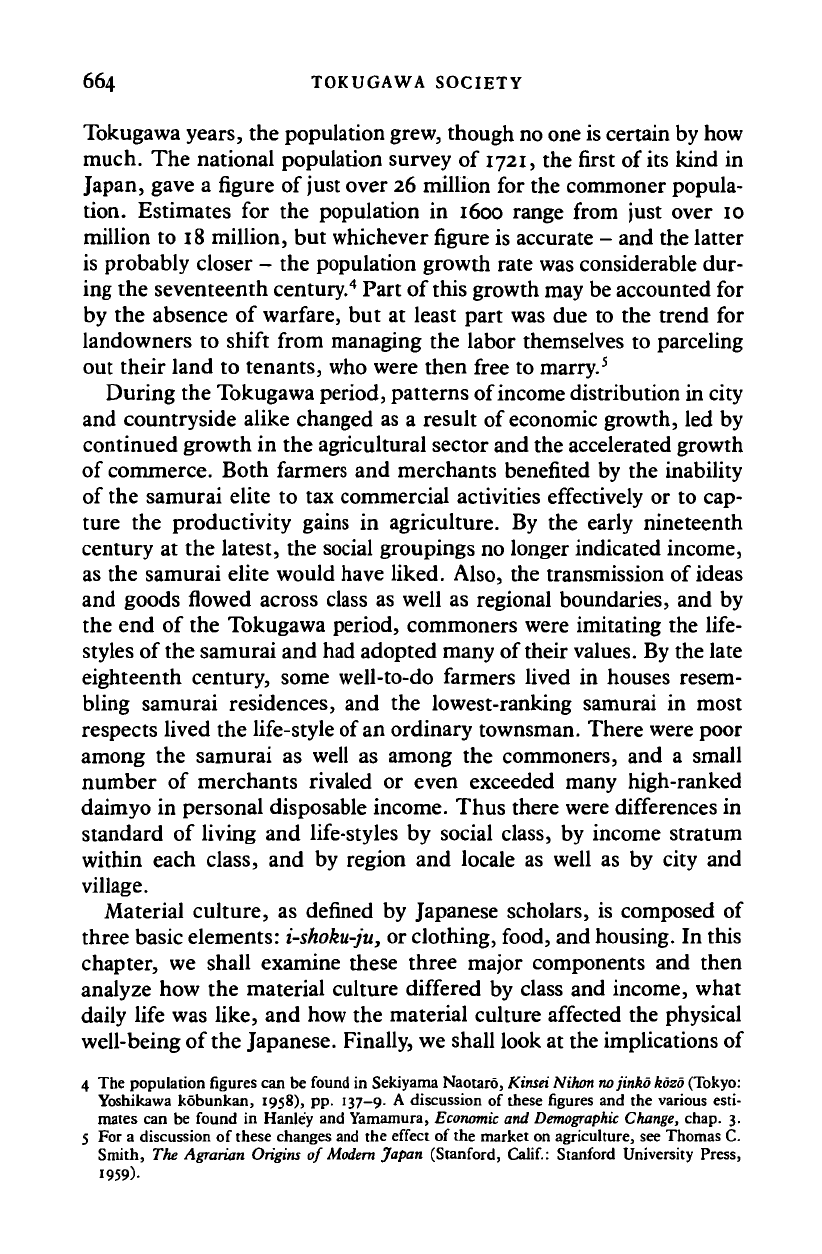
664 TOKUGAWA SOCIETY
Tokugawa years, the population grew, though no one is certain by how
much. The national population survey of
1721,
the first of its kind in
Japan, gave a figure of just over 26 million for the commoner popula-
tion. Estimates for the population in 1600 range from just over 10
million to 18 million, but whichever figure is accurate - and the latter
is probably closer - the population growth rate was considerable dur-
ing the seventeenth century.
4
Part of this growth may be accounted for
by the absence of warfare, but at least part was due to the trend for
landowners to shift from managing the labor themselves to parceling
out their land to tenants, who were then free to marry.
5
During the Tokugawa period, patterns of income distribution in city
and countryside alike changed as a result of economic growth, led by
continued growth in the agricultural sector and the accelerated growth
of commerce. Both farmers and merchants benefited by the inability
of the samurai elite to tax commercial activities effectively or to cap-
ture the productivity gains in agriculture. By the early nineteenth
century at the latest, the social groupings no longer indicated income,
as the samurai elite would have liked. Also, the transmission of ideas
and goods flowed across class as well as regional boundaries, and by
the end of the Tokugawa period, commoners were imitating the life-
styles of the samurai and had adopted many of their values. By the late
eighteenth century, some well-to-do farmers lived in houses resem-
bling samurai residences, and the lowest-ranking samurai in most
respects lived the life-style of an ordinary townsman. There were poor
among the samurai as well as among the commoners, and a small
number of merchants rivaled or even exceeded many high-ranked
daimyo in personal disposable income. Thus there were differences in
standard of living and life-styles by social class, by income stratum
within each class, and by region and locale as well as by city and
village.
Material culture, as defined by Japanese scholars, is composed of
three basic elements:
i-shoku-ju,
or clothing, food, and housing. In this
chapter, we shall examine these three major components and then
analyze how the material culture differed by class and income, what
daily life was like, and how the material culture affected the physical
well-being of the Japanese. Finally, we shall look at the implications of
4 The population figures can be found in Sekiyama Naotaro, Kinsei Nihon nojinko kozo (Tokyo:
Yoshikawa kobunkan, 1958), pp. 137-9. A discussion of these figures and the various esti-
mates can be found in Hanle'y and Yamamura, Economic and
Demographic
Change, chap. 3.
5 For a discussion of these changes and the effect of the market on agriculture, see Thomas C.
Smith, The Agrarian Origins of Modem Japan (Stanford,
Calif.:
Stanford University Press,
1959)-
Cambridge Histories Online © Cambridge University Press, 2008
